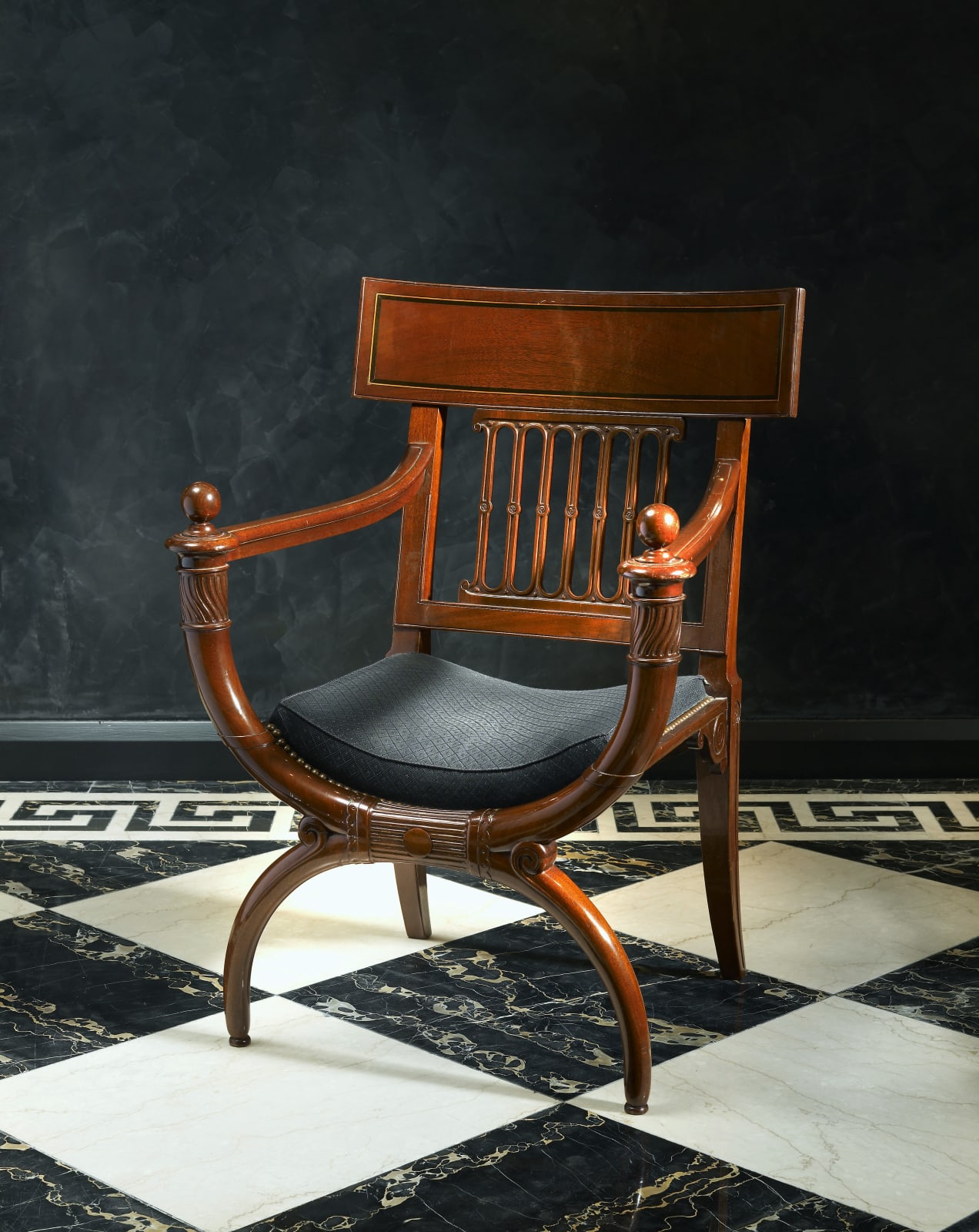Georges Jacob (attributed to) French, 1739-1814
Literature
Madeleine Jarry, "Le Siège en France du Moyen Age à Nos Jours", 1948, pl. 257, illustrating a closely related fauteuil in the Grognot Collection. Marie-Noelle de Grandry, "Le Mobilier Français, Directoire Consulat Empire", 1996, p. 35, illustrating a curule-form fauteuil of very similar design with posterior sabre legs and a pierced backrail resembling an antique Athénienne, in the Musée des Art Décoratifs, Paris. Denise Ledoux-Lebard, "Le Mobilier Français du XIXe Siècle", 2000, p. 283, illustrating a page of designs by Charles Percier for chairs to be made by Georges Jacob, including a drawing of a fauteuil of very similar form as here but with an open back and two sets of x-shaped supports. And p. 283 and 331 illustrating two mahogany fauteuils by Georges Jacob based on Percier's design and thus of very similar form as here. Giacomo Wannenes, "Eighteenth Century French Furniture", 2000, p. 330, illustrating a related mahogany curule-form fauteuil, as here with posterior sabre legs, a pierced backrail resembling an antique Athénienne and a plain panelled seat.
A very fine Directoire mahogany and inlaid ebony fauteuil attributed to Georges Jacob after a design by Charles Percier, the slightly curved rectangular toprail above a pierced channelled back and downswept arms terminated by a ball finial, above a close nailed black upholstered cushion on a curule-form base composed of curved x-shaped front supports, with posterior sabre legs
Paris, date circa 1795
Height 94.5 cm, width 52 cm.
The attribution to the eminent menuisier Georges Jacob (1739-1814) as the maker of this finely sculptured and highly sophisticated fauteuil supported on a curule-form base is on account of a number of factors. Firstly Charles Percier (1764-1838), who was with Pierre François Léonard Fontaine (1762-1853), Napoleon's chief architect and designer, executed a drawing for Georges Jacob of a closely related chair. Jacob then made a number of chairs in this style of which one illustrated in Ledoux-Lebard ibid, p. 285 is as here inlaid with ebony. Though both the executed models had open backs and two sets of curved x-shaped supports, the carved ornament at the junction of the front supports and the seat are of virtually identical design.
Designs for such chairs and other furniture inspired by Antiquity arose from excavations at Pompeii and Herculaneum and was reinforced by Napoleon's Egyptian Campaigns of 1798, as popularised by Baron Vivant-Denon in his "Voyage dans la Basse et la haute Egypte", published in 1802. The curule-shaped chair was however more commonly associated with the ancient Roman seats that were placed in chariots for use by high-ranking magistrates and as one of the designs derived from Antiquity were readily integrated into the repertoire of motifs used by ornemanistes such as Percier and Fontaine.
Furthermore in accordance with the principles of austerity and morality during the Directoire period, artists drew inspiration from the ancient civilisation and thus this form of chair, which closely adhered to such values, was particularly appropriate.
Georges Jacob was undoubtedly the finest menuisier of his day, who from 1773 received numerous commissions from the Crown. In 1781 he was appointed ébéniste-ordinaire to Monsieur, the comte de Provence (later King Louis XVIII) and from 1784 became one of the Fournisseurs des Menus-Plains. As an innovator he drew inspiration from Antiquity for his chairs and in fact made chairs of curule-form prior to the Revolution notably one with x-shaped supports terminating in the heads and feet of animals which he made for and after a design by his friend the artist Jacques-Louis David, circa 1788.
Other earlier pieces to include similarly shaped supports include a suite of mahogany chairs made to the designs of the painter Hubert Robert for Marie-Antoinette's Dairy at Rambouillet, which was delivered in 1787
